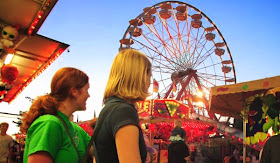Lane County Fair [Photo, creative commons]
For as long as people have harvested crops, they have held festivals to celebrate. Today's county fairs are the direct descendants of the most ancient events. From that day to this, parades and processions, crownings (then of the gods or saints, now of the queen and king of the event), displays of the finest fruits of the harvest, and singing and dancing rule the day. Tractor pulls weren't featured in ancient Greece, but they must have had something noisy.
- Lammas (Loaf Mass) Day. August 1, signaled the beginning of the wheat harvest. The word means “Loaf Mass” in Old English; on that day the first ripe grain was taken to the church to be blessed at a special Mass. In Scotland, men and women made trial marriages on Lammas Day; after a year they could end the marriage with no strings attached. This year, you can celebrate Lammas on July 27 and 28 in Eastbourne, U.K., with music, dance, beer, and food. For good measure, there's a seafront procession (aka parade).They give a nod to Lugh, the Celtic fire god, who gave his name to Lughnasa, the Celtic festival of the harvest. That is celebrated anywhere between about August 1 and August 12 [depending on which website you read].

- In old Slavic traditions, people threw Dvoroi, a yard spirit, a slice of bread to keep him from playing tricks. On the harvest holiday, Zaziuki, August 7, people thanked Volos and Mokosh for the harvest, then carried the first sheaf of wheat into the house and threshed it. [Note -- I can't find any web sites with more information about this, but if you want to toss a slice of bread to Dvoroi, he might be happy with that.]
- In China, the harvest festival featured legends about the moon, and moon cakes made of wheat with fillings of lotus seeds and egg. It is widely celebrated; in 2013 it falls on the full moon night of September 19.

- The Kansas Wheat Festival is in Sumner County, Kansas, which titles itself "The Wheat Capital of the World," and hosts an annual party in Wellington, its county seat. To solidify its claim, the county says that it produces more hard red winter wheat than anywhere else in the world (according to Kansas Wheat Facts, 9 million bushels in 2009.
The 113th festival is held from July 10-14, 2013. You can enjoy dozens of events, from the Mayor's Cookie Jar Contest, to the Cow Chip Throwing Contest, horseshoes, bed races, BBQ cookoffs, and of course, baking, and doughnut eating contests. There's a Kick-off breakfast, bake sales, train rides, chain saw art, Kiss the Pig contest, street dancing every night (with Marty Haggard and others), a beer garden, carnival rides, ice cream social, a parade, antique tractors, softball and volleyball tournaments, and much more.
- You'll have plenty of time to get to a pair of wheat festivals in central Italy in the towns of Lupara and Jelsi. Lupara's is Festa di St. Antonio on July 22; Jelsi's honors Santa Anna on July 26. In Lupara, villagers mount the statue of Saint Anthony on a cart, and two white oxen pull it through the streets, with a band and the feast-goers singing behind. Sheaves of wheat from the successful harvest decorate the cart, and women distribute bread and biscuits. http://www.youtube.com/watch?v=OfOhaVAwlQY. After St. Anthony has been returned to the church, everyone celebrates.
- In Jelsi, a similarly elaborate procession winds through the streets, with floats made from wheat, bands, farm machines, people in Renaissance costumes, and more. http://www.youtube.com/watch?v=MpMKuL0RI4c.

- From Italy, head to Provins, France for a two-day event August 23 and 24.
This year's theme is "folk wisdoms and legends in the Brie area." The events are fewer than in Kansas, but the town promises a parade of wheat-decorated floats, folk dancing, "old-style threshing," a fun fair, and ""jazz and world music." It's free on Saturday, but costs 10 euros on Sunday; kids under 12 are free. The FaceBook page says that people decorate their homes and shops with wheat and wildflowers. They demonstrate the threshing, milling and baking (and one presumes that there's plenty of good French bread to eat at the end of this). The city itself is a UNESCO World Heritage site because of its well-preserved medieval buildings, and there's plenty else to do besides celebrate the wheat harvest.
- Back in Italy, Raddusa in Sicily celebrates its harvest festival early in September. [A Wikipedia entry says that the date is September 19, 2013, but I can't confirm that.] The area grows durum wheat, used in pasta, so that is the featured food.
- Wheat festival parade in Radussa, Italy.
- In mid-September, you can join the Wheat Festival in Okawville, Illinois (it was Bridgeport, but German settlers in the 1870s re-named it). There's not a lot of information about this year's festival, except the dates (September 12 - 14) and the promise of a parade. The 2012 schedule shows bingo, antique tractor pulls, a parade, a queen, music, and an exhibit hall.
- An Indian harvest festival, Baisakhi, is celebrated in the spring, and for the Hindu calendar is also the start of the new year. In the Punjab, people bathe, then pray at the temple before dancing during the day and feasting in the evening.
- The Jewish traditions centered on a pair of harvest festivals, the "Hag Hakatzir" (Reaping festival), and "Hag Habikurim," (Holiday of the First Fruits). The pilgrimage, or procession, to the temple included an ox with gilded horns, music, dancers, and the people carrying their offerings of loaves baked from the first wheat of the harvest. This is a spring festival; the next is June 3-5, 2014.



No comments:
Post a Comment